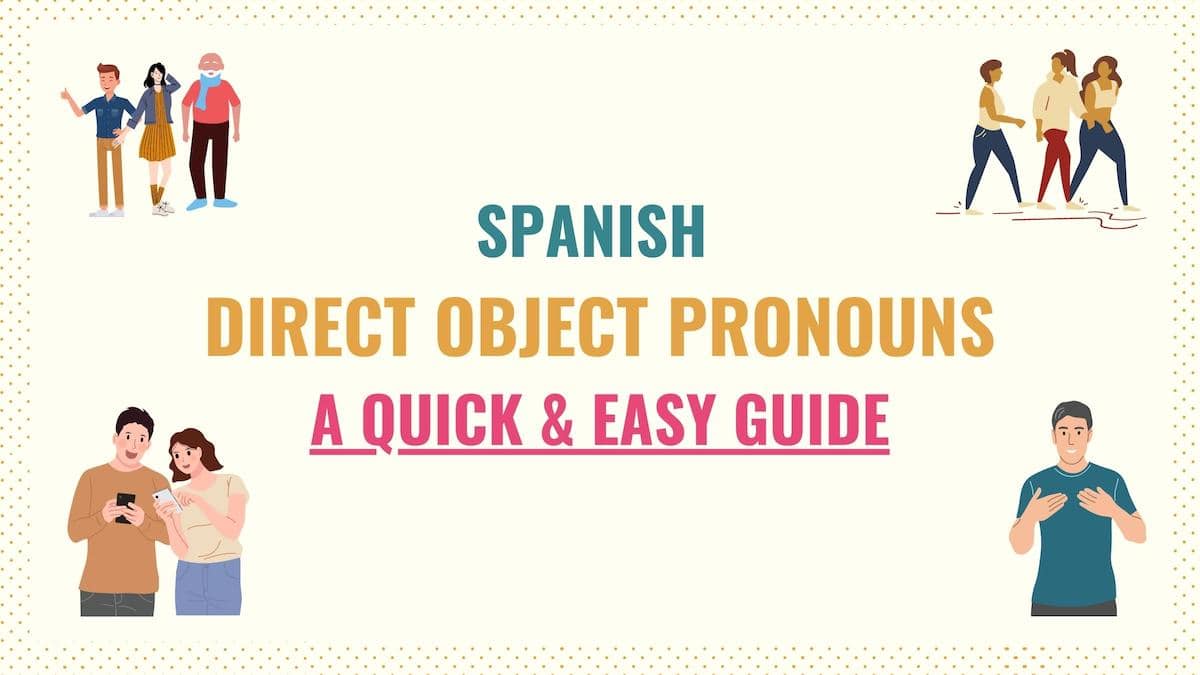Direct object pronouns in Spanish seem intimidating and confusing. However, these Spanish pronouns are essential to sound more natural and fluent. So, in this guide, you’ll learn everything you need to know about direct object pronouns.
Here is a quick overview of what we’ll cover:
- List of All Direct Object Pronouns in Spanish
- Finding a Direct Object in Spanish
- How to Use Spanish Direct Object Pronouns
- Where Do Spanish Direct Object Pronouns Go?
- Bonus: Verbs that Work with Direct Object Pronouns
- Key Points
- Downloadable PDF: Direct Object Pronouns Cheat sheets
- Practice Quiz
To make things easier, I’ve included graphics and examples. By the end of it, you should feel more comfortable using Spanish direct object pronouns.
Tip: Misplacing or not using direct object, reflexive and indirect object pronouns is one of the most common mistakes that lead to speaking broken Spanish.
Spanish Direct Object Pronouns (Chart & List)
Spanish direct object pronouns are:
- Me – Me
- Te – You (informal)
- Lo – Him / It / You (formal)
- La – Her / It / You (formal)
- Nos – Us
- Os – You (plural)
- Los / Las – They / You (plural)
Direct object pronouns replace the direct object. Since the direct object is a noun or a noun phrase, third person direct object pronouns must agree with the number and gender of the noun they’re replacing. For instance:
¿Y las llaves? ¿No las has visto?
And the keys? Have you seen them?
Creo que es el primo de Joan, pero no lo conozco.
I think he is Joan’s cousin, pero I don’t know him.
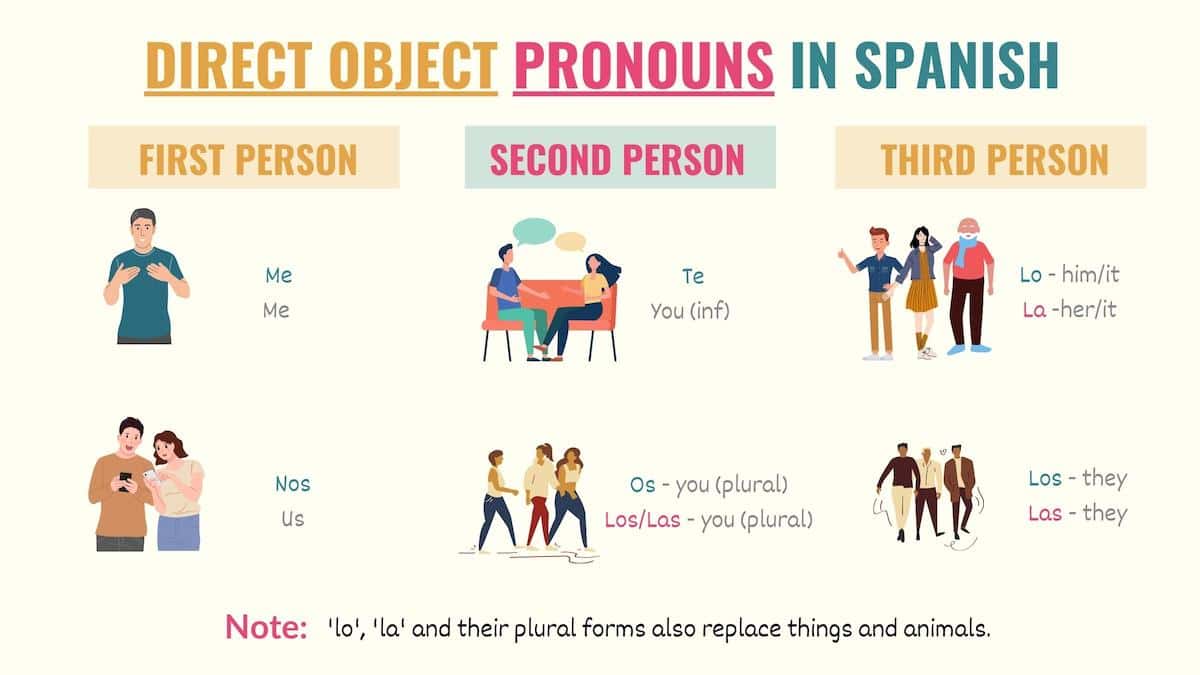
What Is a Direct Object in Spanish & How to Find It
As its name suggests, Spanish direct object pronouns replace the direct object of a sentence. So, to be able to use these pronouns, you first need to identify the direct object.
In Spanish, a direct object is a noun that receives the action in a sentence. This noun can refer to a thing, animal, or person.
Check these sentences with a Spanish direct object:
Juan ve la television.
Juan watches TV.
Voy a bañar a los perros.
I’m going to bathe the dogs.
Ustedes quieren mucho a su mamá.
You guys love your mom very much.
To find a direct object in Spanish, you must ask “what?” or “whom?” to the verb.
Let me use the previous examples to show you how to find the direct object in Spanish.
In the first example, Juan is performing the action (to watch – ver). To find the direct object, we ask what is Juan watching? TV! You can ask the same question to find the direct object in sentence #2.
Let’s do example #3 together. In this sentence, ‘ustedes’ is the subject, and ‘love’ is the action. To find the Spanish direct object, I would ask what or whom do you guys love? And the answer is: your mom!
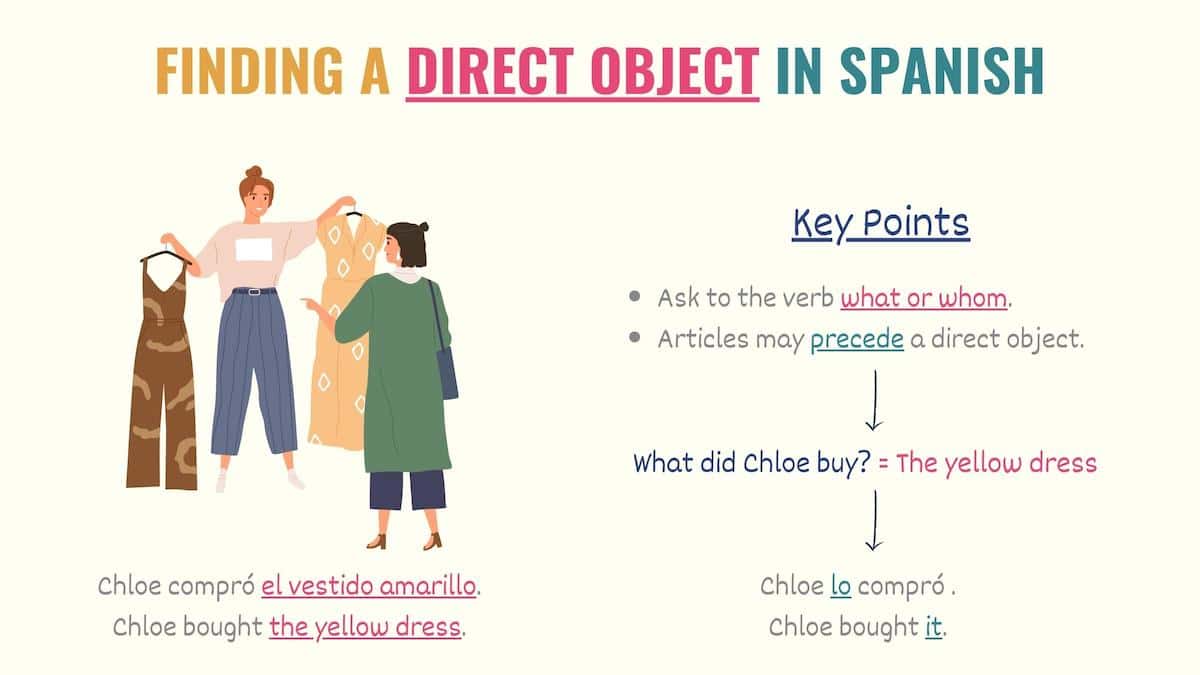
Now that you know what a direct object is and how to find it. Let’s see how to use Spanish direct object pronouns.
Tip: Because of Spanish’s structure, direct objects are usually the element that is closer to the verb.
When & How to Use Direct Object Pronouns in Spanish
Like any other Spanish pronoun, direct object pronouns avoid repetition by replacing the direct object of a sentence. We use direct object pronouns when the direct object has been mentioned before or when it’s implicit.
One of the key rules of direct object pronouns in Spanish is that when using third person pronouns (la, lo, and their plural forms), you must choose a pronoun that agrees with the gender and number of the noun they’re replacing. Check the examples below:
Sentences using a direct object:
Dame la pelota, por favor.
Give me the ball, please.
Sergio compró unos chocolates.
Sergio bought some chocolates.
¿Quién quiere probar las galletas?
Who wants to taste the cookies?
Emma esperó a sus amigos.
Emma waited for her friends.
Sentences with direct object pronouns:
Dámela, por favor.
Give it to me, please.
Sergio los compró.
Sergio bought them.
¿Quién quiere probarlas?
Who wants to taste them?
Emma los esperó.
Emma waited for them.
Susie me vio con Alejandro.
Susie saw me with Alejandro.
Check the last example. This sentence uses the direct object pronouns without having an antecedent (a counterpart example with the direct object). However, we know we need a direct pronoun because it answers the question: what did Susie see? Me!
Placing Direct Object Pronouns in Spanish
One of the most challenging things of Spanish direct object pronouns is placing them correctly within a sentence. As you may have noticed, in Spanish, the order of direct object pronouns varies depending on the conjugation of the verb.
Spanish direct object pronouns go:
- Before a conjugated verb (sentences with one verb, perfect tenses, negative commands):
Ya la vi.
I already saw it.
¡No lo toquen!
Don’t touch it!
Te he comprado un suéter.
I bought you a sweater.
- Attached to affirmative commands, infinitive verbs or gerunds:
Apágala, por favor.
Turn it off, please.
Romperlo no va a resolver nada.
Breaking it is not going to fix anything.
Progressive tenses (such as the Spanish present progressive) and verbal phrases (for example, the near future) are formed with a conjugated verb and a verb in gerund or infinitive form. So, with these types of tenses, you have two options: placing the pronoun before the conjugated verb or attach it to the infinitive or gerund:
Voy a comprarla.
I’m going to buy it.
La voy a comprar.
I’m going to buy it.
Estoy escuchándote.
I’m listening to you.
Te estoy escuchando.
I’m listening to you.
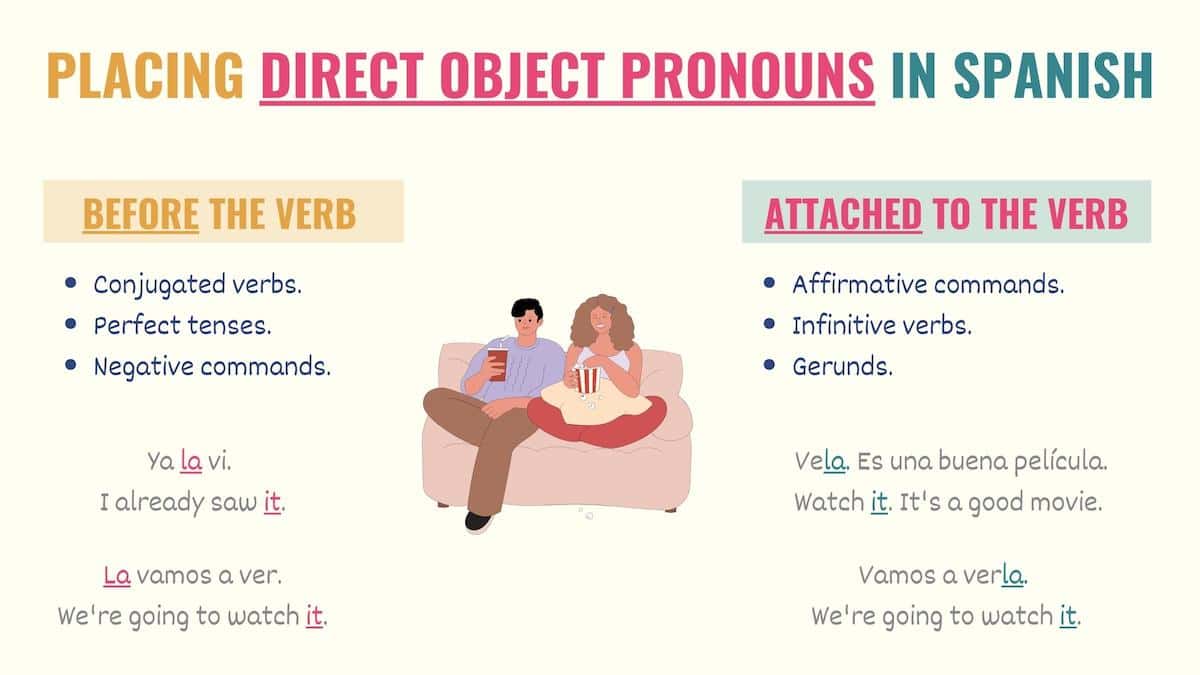
Take Note: In Spanish, double object pronouns are sentences where you replace both direct and indirect objects. With these types of sentences, direct object pronouns must be placed after the indirect object pronoun – Juan me la dio (Juan gave it to me).
Spanish Verbs that Work Direct Object Pronouns
In Spanish, transitive verbs must always be followed by a direct object because the sentence would be incomplete without it.
Examples of some verbs in Spanish that work direct object pronouns include:
- Amar – To love
- Ayudar – To help
- Bañar – To bathe / To shower
- Buscar – To look for
- Comprar – To buy
- Conocer – To meet / To know
- Cuidar – To take care of
- Dar – To give
- Dejar – To leave
- Despertar – To wake up
- Encontrar – To find
- Escuchar – To listen to
- Esperar – To wait
- Hacer – To do / To make
- Invitar – To invite
- Limpiar – To clean
- Llevar – To take
- Mandar – To send
- Mover – To move
- Necesitar – To need
- Oír – To hear
- Pedir – To ask / To order
- Perder – To lose
- Perdonar – To forgive
- Preparar – To prepare
- Querer – To want
- Sacar – To take out
- Saludar – To greet
- Seguir – To follow
- Tocar – To touch
- Tomar – To take
- Usar – To use
- Ver – To see / To watch
- Visitar – To visit
Take Note: Spanish reflexive verbs are transitive verbs. This means that if you’re not performing the action on yourself, you may use a direct object.
Key Points
Direct object pronouns in Spanish are a crucial part of many sentences. Since they can help shorten your sentences while sounding more natural, direct object pronouns are necessary for fluent communication. Here are the key points to remember:
- Spanish direct object pronouns are me, te, lo, la, nos, os, los, and las.
- A direct object is a noun that receives the action of the verb. It can be a person, thing, or animal.
- Since they replace nouns, direct object pronouns must agree with the noun’s gender and number.
- Direct object pronouns answer the questions ‘what’ or ‘whom’ is receiving this action (verb).
- Spanish direct object pronouns are always placed in front of the conjugated verb in sentences with one verb, negative commands, or when using perfect tenses.
- Spanish direct pronouns are always attached to affirmative commands, infinitives, or gerunds.
- With progressive tenses, Spanish direct object pronouns can be placed before the conjugated verb or attached to the infinitive verb.
Download the Spanish Direct Object Pronouns PDF
I’ve created a PDF with cheat sheets for you to download including the graphics from this guide so that you can refer to it whenever you need a refresher on how to use, place or identify direct object pronouns in Spanish.
Practice Quiz: DOPs in Spanish
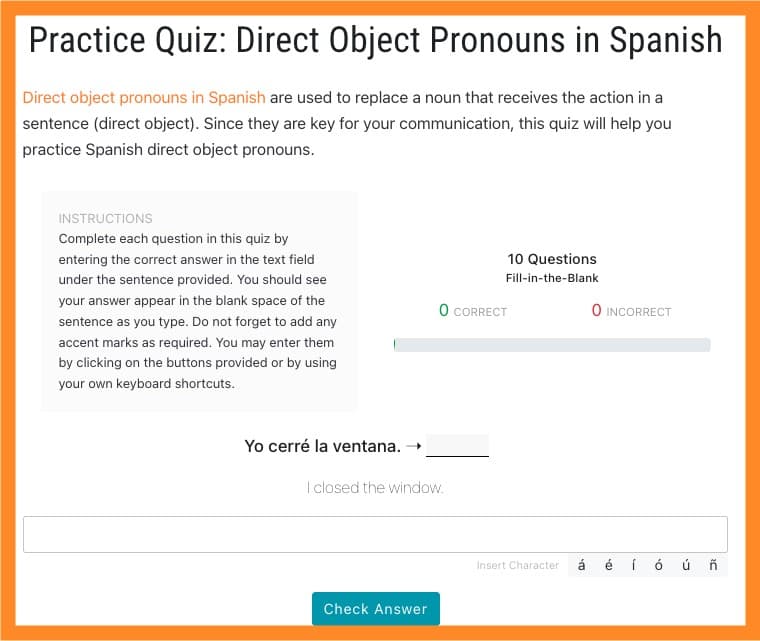
Ahora que ya los entiendes (now that you understand them), it’s time for you to start applying these pronouns to your conversations. You can start practicing your use of direct object pronouns in Spanish by taking this quiz.

